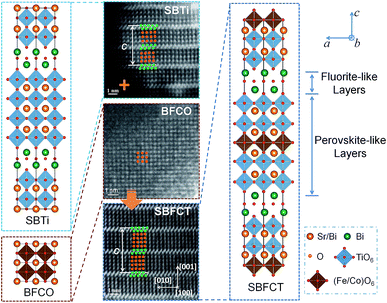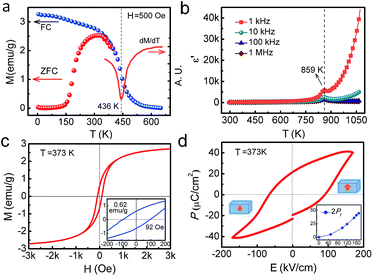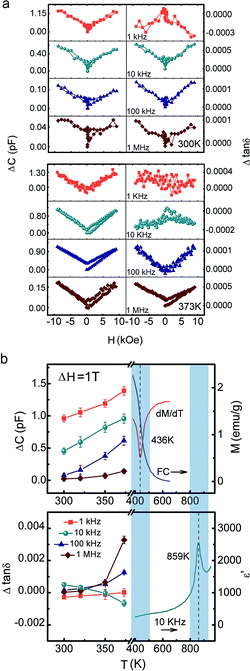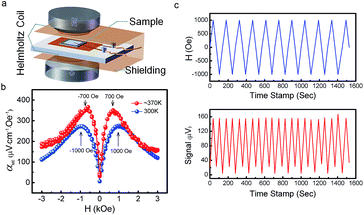Low magnetic field response single-phase multiferroics under high temperature†
Jianlin
Wang
a,
Zhengping
Fu
abc,
Ranran
Peng
ac,
Min
Liu
ac,
Shujie
Sun
a,
Haoliang
Huang
a,
Lin
Li
a,
Randy J.
Knize
d and
Yalin
Lu
*abcd
aCAS Key Laboratory of Materials for Energy Conversion, Department of Materials Science and Engineering, University of Science and Technology of China, Hefei 230026, P. R. China
bHefei National Laboratory for Physical Sciences at the Microscale, University of Science and Technology of China, Hefei 230026, P. R. China
cSynergetic Innovation Center of Quantum Information & Quantum Physics, University of Science and Technology of China, Hefei 230026, P. R. China
dLaser and Optics Research Center, Department of Physics, United States Air Force Academy, Colorado 80840, USA. E-mail: yllu@ustc.edu.cn
First published on 19th November 2014
Abstract
A single-phase material where ferroelectricity and ferromagnetism coexist at room temperature (RT) is hardly available at present, and it is even more rare for such a material to further have an intrinsic and low magnetic field response magnetoelectric (ME) coupling at temperatures higher than RT. In this communication, a new single-phase Aurivillius compound, SrBi5Fe0.5Co0.5Ti4O18 has been discovered that exhibits a plausible intrinsic ME coupling. Remarkably, this property appears at a high temperature of 100 °C, surpassing all single-phase multiferroic materials currently under investigation. With a magnetocapacitance effect detectable at 100 °C and under a low response magnetic field, a RT functioning device was demonstrated to convert an external magnetic field variation directly into an electric voltage output. The availability of such a single-phase material with an intrinsic and low magnetic field response that is multiferroic at high temperature is important to the fundamental understanding of physics and to potential applications in sensing, memory devices, quantum control, etc.
Conceptual insightsBismuth ferrite (BiFeO3) has been almost the only “star” in the field of high temperature single phase multiferroics in the last decade. Spontaneous polarization and magnetization naturally repel each other in single phase crystals, because of the contradictory requirements of the “d0” rule in ferroelectrics and the partially occupied d-orbital required for ferromagnetism. This work demonstrates that a new single-phase material with intrinsic multiferroic properties and considerable magnetoelectric (ME) coupling well above room temperature (RT) can be realized, for the first time, by inserting a magnetic layer into the ferroelectric host of an Aurivillius phase material. This work will stimulate the design of high temperature intrinsic and single-phase multiferroic materials, produce many novel multiferroic materials that are ready-to-hand for researchers, and also push multiferroic materials into practical applications such as spintronic devices, high density memory devices, low-power sensors, etc. |
Developing bulk multiferroic materials in a single-phase format using methods other than the intensively investigated artificial stacking together of ferroelectric (FE) and ferromagnetic (FM) materials into multiferroic composites represents a new trend in recent years.1–3 The criteria used to evaluate a potential single-phase multiferroic material include: (1) large FE and FM properties; (2) high FE and FM transition temperatures (much higher than RT); and (3) a strongly correlated magnetoelectric (ME) coupling that occurs at high temperatures, together with the ability to be driven by as low an external electric or magnetic field as possible, in order to ensure improved operation stability at RT. To date, many single-phase materials, including BiFeO3,4,5 TbMnO3,6,7 HoMnO3,8,9 and CuO,10 have been studied. However, none of them have been able to simultaneously meet all of the above criteria, and the majority possess FE and FM ordering at low temperatures (much lower than RT). Specifically, none of these materials so far have shown a detectable and low field responsive ME coupling at RT. For example, bulk BiFeO3 has Tc ∼ 1103 K, TN ∼ 643 K and a plausible coupling, but, unfortunately, exhibits a large amount of leakage and unwanted canted G-type antiferromagnetic (AFM) ordering at RT.4,11,12 In the effort to battle against such challenges, meeting the criteria of a strong RT ME coupling is of the highest priority.
Magnetic-layer-insertion (MLI, a phenomenological word to describe the method) into layered bismuth Aurivillius materials,13 which normally appeared as ferroelectrics in the past, may potentially produce single-phase multiferroic materials.14 Bismuth Aurivillius materials are actually a large family of oxides with the general formula Bi2Mn−1RnO3n+3 (where M = Bi, Pb, Sr, etc., R = Ti, Ta, Fe, etc. and n is the number of perovskite slabs). Implementation of MLI requires careful selection of both the host and insertion material, in order to form a single-phase structure. For the former, a material with a good FE performance, low leakage, and a stable, yet tolerant structure is preferred. While for the latter, good FM performance and the potential to be congruent with various magnetic dopants are key. In this work we have constructed a single-phase SrBi4Ti4O15 (SBTi) Aurivillius host material by inserting SrTiO3 into well known Bi4Ti3O12 (BiT). SBTi was formed with a much improved FE performance over BiT, which suffers from “fatigue”.15 SBTi was found to have a large saturated remanent polarization16 (Pr) of 29 μC cm−2 and a strong “fatigue” resistance comparable to that of the well-known FE material SrBi2Ta2O9 (SBT).17 Considering the insertion material, on the other hand, BiFe(1−x)CoxO3 was chosen, as it is congruent with the doping of Co and exhibits enhanced magnetization compared to BiFeO3.18 We initially selected the half Co3+ substituted BiFeO3 compound, pseudo-cubic BiFe0.5Co0.5O3 (BFCO-0.5), for insertion. Therefore, via the insertion of BFCO-0.5 into SBTi, a new single-phase multiferroic material, SrBi5Fe0.5Co0.5Ti4O18 (SBFCT), was obtained. This new material shows negligible leakage and significantly improved FE and FM responses well above RT. Most remarkably, both the FE and FM responses are strongly correlated inside the single-phase structure, resulting in an intrinsic, yet low field, responsive ME coupling, even at a high temperature of ∼100 °C. Using this new material, a stable magnetic field controlled device was demonstrated, which functions well at RT and under a low magnetic field.
Fig. 1 shows a schematic of the MLI approach applied to create SBFCT. BFCO-0.5 is a simple perovskite with Fe3+ and Co3+ ions randomly occupying B-sites to form BO6 octahedra. SBTi and SBFCT are of the Aurivillius-type structure with four and five slabs of BO6 octahedra sandwiched between two Bi2O22+ fluorite-like layers, respectively. The new material, SBFCT was obtained by inserting BFCO-0.5 into SBTi with two calcination steps (see ESI†). The three images in the middle of Fig. 1 show Bi (and Sr) atoms in both SBTi (top) and SBFCT (bottom), indicating that there are three/four Bi (or Sr) layers (corresponding to four/five BO6 octahedral slabs) sandwiched between two Bi2O22+ layers, and the perovskite structure of BFCO-0.5 (middle), which is disclosed from high-angle annular dark-field (HAADF) images taken using an aberration-corrected scanning transmission electron microscope (STEM). The resulting lattice parameters are 40.96 Å for cSBTi and 49.21 Å for cSBFCT, which are consistent with values obtained from the XRD Rietveld refinement,19 (40.95 Å16 for cSBTi and 49.184 Å for cSBFCT) (See Fig. S2†). The above results support successful insertion, which leads to pure single-phase SBFCT. It is worth noting that the central perovskite layer of SBFCT shown in brown in Fig. 1 is a phenomenological description of the MLI method. In fact, Fe or Co occupied octahedra may distribute in a disordered fashion inside the five sandwiched perovskite layers. Unfortunately, accurate experimental determination of the distribution is difficult. For example, the Rietveld refinement is less sensitive to the ordering of Ti, Fe and Co cations, due to the fact that their X-ray scattering powers are all similar.
Temperature dependencies of the zero-field-cooled (ZFC) and field-cooled (FC) magnetization at a magnetic field of 500 Oe for SBFCT are shown in Fig. 2a. The FM Curie temperature (TCM), defined by the peak of the differential −dM/dT, is about 436 K. The ZFC curve also shows a peak near 330 K and a separation from the FC curve, indicating the appearance of spin glass-like behavior.20 Temperature dependency of the dielectric constant at different test frequencies of 1, 10, 100 and 1000 kHz is shown in Fig. 2b. The FE Curie temperature, TCE, is 859 K, which is higher than that of the host, SBTi (795 K) (Fig. S3†). The significance of the above observations is that both the FE and FM transition temperatures are above RT, which makes SBFCT attractive for future device development. In order to justify use for potential devices in terms of their working stability and reliability at RT, it is reasonable to select a high working temperature of 373 K for further tests on this new SBFCT material.
Fig. 2c shows the FM hysteresis loop of SBFCT with a saturated magnetic moment (Ms) of ∼2.6 emu g−1, a remanent moment (Mr) of ∼0.62 emu g−1 and a coercive field (Hc) of ∼92 Oe at 373 K. Compared to the host, SBTi, which is weakly diamagnetic (Fig. S4a†), the resulting SBFCT becomes FM after BFCO-0.5 insertion. The enhanced magnetization can be ascribed to the spin canting of the Fe- and Co-based sub-lattices via the Dzyaloshinskii–Moriya interaction.21,22 X-ray photoelectron spectroscopy measurements also indicate an enhanced interaction strength between Co–O bonds (see Fig. S5†), which contributes to the total magnetic moment.
In order to eliminate any possible contributions from other FM secondary phase impurities,23 we separately synthesized two FM phases that most commonly occur as impurities in the layered Aurivillius materials, BFCO-0.5 and CoFe2O4. A magnetic thermogravimetric analysis (MTGA) technique24 was used to determine TCM of the materials. The measured TCM for SBFCT was 440.8 K, which is quite close to the above M–T measurement (∼436 K). The TCM values for CoFe2O4 and BFCO-0.5 were 720.5 and 744.8 K (Fig. S6†), respectively. These values do not appear in the SBFCT tests and are also far away from that of SBFCT itself. Therefore, it is reasonable to exclude these two impurities as contributors to the measured ferromagnetism, indicating the intrinsic magnetization of SBFCT.
The polarization versus electric field (P–E) hysteresis of SBFCT at 373 K is shown in Fig. 2d. SBFCT exhibits a 2Pr value of 44.5 μC cm−2 and a coercive electric field (2Ec) of 156 kV cm−1 at an electric field of 170 kV cm−1, indicating excellent FE performance after the BFCO-0.5 insertion into SBTi (2Pr increases from 4.18 μC cm−2 (SBTi) to 24.2 μC cm−2 at 100 kV cm−1) (Fig. S7†). This enhancement may relate to insertion-induced structural distortion and to the high resistivity of ∼1 × 1013 ohm cm measured for SBFCT at RT (Fig. S9†), which is about four orders higher than that of Co-doped BiFeO3 (<109 ohm cm at RT25). Fatigue tests showed almost no degradation of the polarization after 109 cycles of up-and-down switches at a frequency of 1 kHz and under an electric field of 150 kV (Fig. S8c†).
Magnetocapacitance (MC) measurements were performed to assess the ME coupling.26,27 The magnetic field dependencies of the dielectric constant and loss, tested at temperatures of 300 K and 373 K, respectively, are shown in Fig. 3a. The changes in both the recorded magnetic capacitance and loss are quite similar to that of the superlattice model.28 We have applied a Maxwell–Wagner (M–W) leaky capacitor model to our sample (see ESI†), and the results indicate that the layer-structured of SBFCT is indeed similar to a ‘natural’ superlattice.29 A “cut off” phenomenon around 1 MHz was also observed, confirming the existence of an intrinsic ME coupling.27,28 This strong ME coupling may relate to the superlattice-like structure, in which there are many interfaces, randomly distributed Fe and Co ions and distorted octahedra. X. Zhai et al. reported that the magnetism in epitaxial (LaMnO3+δ)N/(SrTiO3)N superlattices is strongly related to interfacial octahedral rotation.30 This rotation or distortion may further correlate with the ferroelectricity, which may explain the observed intrinsic ME coupling in this work.
In the past, a large MC effect has usually been observed at or near the transition temperatures, such as in SeCuO3 and TeCuO3 compounds at their FM (TCM = 25 K) and AFM (TN = 9 K) transition temperatures,31 in YFe1−xMnxO3 at its spin-reorientation temperature,32 and in Bi4.2K0.8Fe2O9+δ at its FE (TCE = 270 K) transition temperature.33 Here, the measured MC phenomenon occurs over a wide temperature range from RT to greater than 373 K, which is far away from its FM (TCM ∼ 436 K) and FE (TCE ∼ 859 K) transition temperatures, as shown in Fig. 3b. This indicates a distinct yet stable MC effect, which will be substantially important for actual device development.
Using this new SBFCT material a prototype ME device was fabricated, which uses a dynamic technique to directly convert a magnetic signal to an electric voltage output.34Fig. 4a shows a schematic of the device working under both a tunable DC and AC magnetic field. Inside the device, an electrically poled SBFCT acts as the core sensing component generating the electric potential via interaction with an applied oscillating magnetic field. Fig. 4b shows a plot of the ME coupling coefficient αMEversus the DC field (H). The coefficient reaches ∼270 μV cm−1 Oe−1 at a low DC field of 1000 Oe at RT and ∼350 μV cm−1 Oe−1 at a low DC field of 700 Oe at 373 K, the latter is about 5 times larger than the value (64 μV cm−1 Oe−1) measured for BiFeO3 at RT.35 This sharp “M-type” curve is similar to those seen for previously developed laminated composite multiferroics.1Fig. 4c shows the effect of a periodic magnetic field on the induced voltage output in triangular wave mode format. The output instantly and reliably responds to the low input magnetic field. In a low magnetic field (<100 Oe), a noticeable ME signal output can still be instantly detected.
Conclusions
In summary, a new single-phase and intrinsically multiferroic material (SBFCT) has been developed, which functions well at high temperature (373 K) and under a low magnetic field. Using this new material, a prototype ME device was made, which demonstrated excellent low field and reliable high temperature responses. The availability of this new material is important for basic physics research and for future device development.Acknowledgements
This work was supported by the National Basic Research Program of China (973 Program, 2012CB922000). Dr Lu appreciates support for the device design and testing from Quantum Design in China.Notes and references
- J. Ma, J. Hu, Z. Li and C.-W. Nan, Adv. Mater., 2011, 23, 1062 CrossRef CAS PubMed.
- N. A. Spaldin and M. Fiebig, Science, 2005, 309, 391 CrossRef CAS PubMed.
- N. A. Spaldin, S.-W. Cheong and R. Ramesh, Phys. Today, 2010, 63, 38 CrossRef PubMed.
- J. Wang, J. B. Neaton, H. Zheng, V. Nagarajan, S. B. Ogale, B. Liu, D. Viehland, V. Vaithyanathan, D. G. Schlom, U. V. Waghmare, N. A. Spaldin, K. M. Rabe, M. Wuttig and R. Ramesh, Science, 2003, 299, 1719 CrossRef CAS PubMed.
- T. Ito, T. Ushiyama, Y. Yanagisawa, R. Kumai and Y. Tomioka, Cryst. Growth Des., 2011, 11, 5139 CAS.
- T. Kimura, T. Goto, H. Shintani, K. Ishizaka, T. Arima and Y. Tokura, Nature, 2003, 426, 55 CrossRef CAS PubMed.
- S.-W. Cheong and M. Mostovoy, Nat. Mater., 2007, 6, 13 CrossRef CAS PubMed.
- T. Lottermosera and M. Fiebig, Phys. Rev. B: Condens. Matter Mater. Phys., 2004, 70, 220407 CrossRef.
- I. A. Sergienko, C. Sen and E. Dagotto, Phys. Rev. Lett., 2006, 97, 227204 CrossRef.
- T. Kimura, Y. Sekio, H. Nakamura and T. Siegrist, Nat. Mater., 2008, 7, 291 CrossRef CAS PubMed.
- G. Catalan and J. F. Scott, Adv. Mater., 2009, 21, 2463 CrossRef CAS.
- A. K. Pradhan, K. Zhang, D. Hunter, J. B. Dadson, G. B. Loutts, P. Bhattacharya, R. Katiyar, J. Zhang, D. J. Sellmyer, U. N. Roy, Y. Cui and A. Burger, J. Appl. Phys., 2005, 97, 093903 CrossRef PubMed.
- B. Aurivillius, Ark. Kemi, 1949, 1, 463 CAS.
- N. A. Lomanova, M. I. Morozov, V. L. Ugolkov and V. V. Gusarov, Inorg. Mater., 2006, 42, 189 CrossRef CAS.
- B. H. Park, B. S. Kang, S. D. Bu, T. W. Noh, J. Lee and W. Jo, Nature, 1999, 401, 682 CrossRef CAS PubMed.
- H. Irie and M. Miyayama, Appl. Phys. Lett., 2001, 79, 251 CrossRef CAS PubMed.
- C. A-Paz de Araujo, J. D. Cuchiaro, L. D. McMillan, M. C. Scott and J. F. Scott, Nature, 1995, 374, 627 CrossRef.
- H. Naganuma, S. Yasui, K. Nishida, T. Iijima, H. Funakubo and S. Okamura, J. Appl. Phys., 2011, 109, 07D917 Search PubMed.
- G. Will, Powder Diffraction: The Rietveld Method and the Two-Stage Method, Springer, Berlin, GER, 2006 Search PubMed.
- X. Mao, W. Wang, X. Chen and Y. Lu, Appl. Phys. Lett., 2009, 95, 082901 CrossRef PubMed.
- J. Yang, W. Tong, Z. Liu, X. B. Zhu, J. M. Dai, W. H. Song, Z. R. Yang and Y. P. Sun, Phys. Rev. B: Condens. Matter Mater. Phys., 2012, 86, 104410 CrossRef.
- I. A. Sergienko and E. Dagotto, Phys. Rev. B: Condens. Matter Mater. Phys., 2006, 73, 094434 CrossRef.
- L. Keeney, T. Maity, M. Schmidt, A. Amann, N. Deepak, N. Petkov, S. Roy, M. E. Pemble and P. W. Whatmore, J. Am. Ceram. Soc., 2013, 96, 2339 CrossRef CAS PubMed.
- R. L. Blaine and P. G. Fair, Thermochim. Acta, 1983, 67, 233 CrossRef CAS.
- S. Yasui, M. Nakajima, H. Naganuma, S. Okamura, K. Nishida, T. Yamamoto, T. Iijima, M. Azuma, H. Morioka, K. Saito, M. Ishikawa, T. Yamada and H. Funakubo, J. Appl. Phys., 2009, 105, 061620 CrossRef PubMed.
- T. Kimura, T. Goto, H. Shintani, K. Ishizaka, T. Arima and Y. Tokura, Nature, 2003, 426, 55 CrossRef CAS PubMed.
- H. M. Jang, J. H. Park, S. Ryu and S. R. Shannigrahi, Appl. Phys. Lett., 2008, 93, 252904 CrossRef PubMed.
- G. Catalan, Appl. Phys. Lett., 2006, 88, 102902 CrossRef PubMed.
- P. Ghosez and J.-M. Triscone, Nat. Mater., 2011, 10, 269 CrossRef CAS PubMed.
- X. Zhai, L. Cheng, Y. Liu, C. M. Schleputz, S. Dong, H. Li, X. Zhang, S. Chu, L. Zheng, J. Zhang, A. Zhao, H. Hong, A. Bhattacharya, J. N. Eckstein and C. Zeng, Nat. Commun., 2014, 5, 4283 Search PubMed.
- G. Lawes, A. P. Ramirez, C. M. Varma and M. A. Subramanian, Phys. Rev. Lett., 2003, 91, 257208 CrossRef CAS.
- P. Mandal, V. S. Bhadram, Y. Sundarayya, C. Narayana, A. Sundaresan and C. N. R. Rao, Phys. Rev. Lett., 2011, 107, 137202 CrossRef CAS.
- S.-N. Dong, Y.-P. Yao, J.-Q. Li, Y.-J. Song, Y.-K. Liu and X.-G. Li, Sci. Rep., 2013, 3, 1 Search PubMed.
- M. M. Kumar, A. srinivas, S. V. Suryanarayana, G. S. Kumar and T. Bhimasankaram, Bull. Mater. Sci., 1998, 21, 251 CrossRef CAS.
- S. V. Suryanarayana, Bull. Mater. Sci., 1994, 17, 1259 CrossRef CAS.
Footnote |
| † Electronic supplementary information (ESI) available. See DOI: 10.1039/c4mh00202d |
| This journal is © The Royal Society of Chemistry 2015 |




